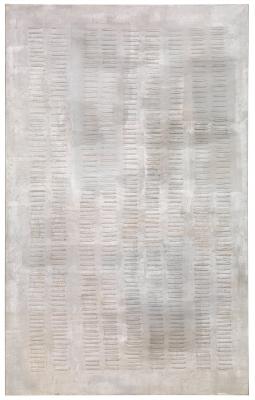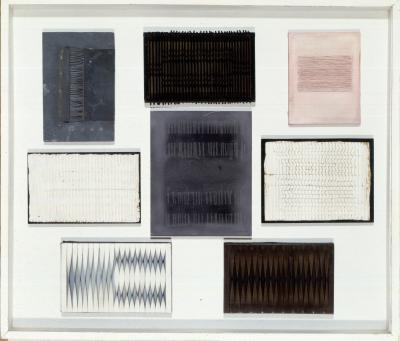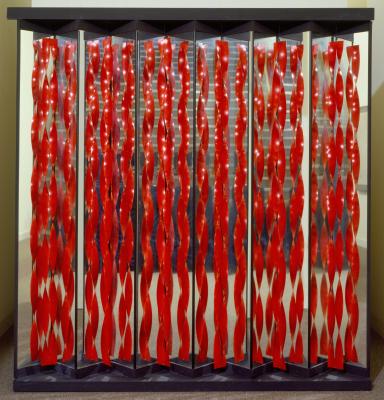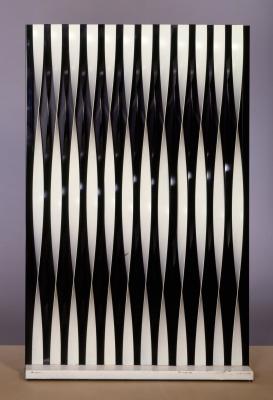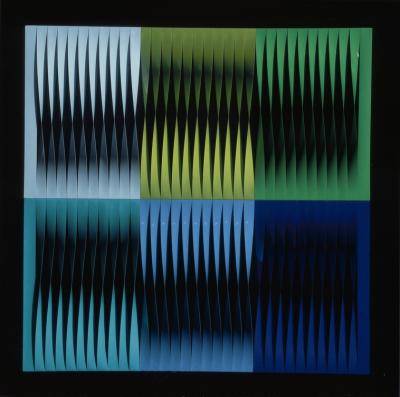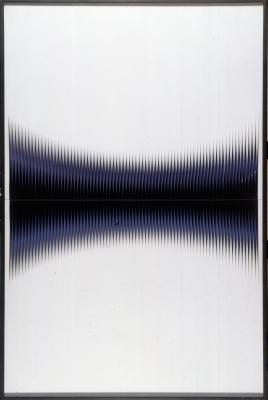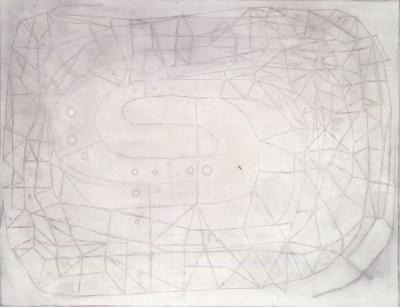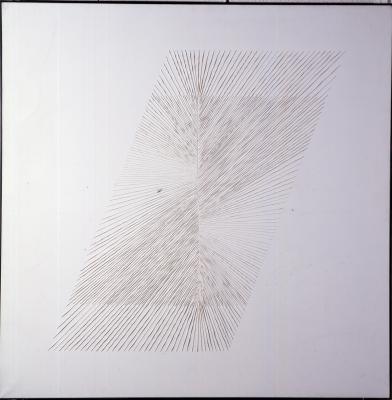Around the late 1950’s, the artist Walter Leblanc explores the sense of law of classical painting. Leblanc is active within the international, neo-avant-garde network of the Nouvelle Tendance, Zero, op art, kinetic art, concrete art and (neo)constructivism. The international group exhibition Anti-Peinture (1962), which he organises in the Antwerp G58-Hessenhuis, where he is a member and later board member, serves as his manifesto. Both in Belgium and abroad, Leblanc is involved in high-profile exhibitions.
Leblanc is trained at the Antwerp SISA (1949 - 1954), the Academy and the NHISKA (1955 - 1956). In the latter institution he gives lessons from 1977 to 1986. In 1956, Leblanc paints his first real abstract works. By way of plastic experiment, he adds sand and cotton thread. In 1958, Leblanc becomes a founding member of G58. He creates his first relief-like monochromes (or twisted strings), after which he systematically evolves towards strictly functional works of art. Around 1960 he takes part in a few controversial (inter)national group exhibitions, amongst which are Monochrome Malerei (Leverkusen, 1960) and Anti-Peinture (Antwerp, 1962). He finds an association with Zero and also participates in expositions with Zero artists, but does not become an active member of the group. Leblanc’s repertoire finds a close connection with the neo-constructivist tendencies for the Nouvelle Tendance, op art and kinetic art. The artist takes part in the Ghent Forum Exhibition of 1962 and 1963. Although the figurative neo-avant-garde begins to take the upper hand, Leblanc’s stark geometry is still well received. It results in an individual exhibition at Glaerie Ad Libitum in 1962 and participation in the important group exhibitions such as The Responsive Eye (MoMA, New York), Zero Avant-garde (Milan), Werk van de internationale avant-garde (Work of the international avant-garde) (Amsterdam) and Licht und Bewegung—Kinetische Kunst (Light and Movement—Kinetic Art) (Bern, Baden-Baden, Düsseldorf). From the late 1960’s, with his repetitive geometry, Leblanc no longer fits in with the arising conceptual tendencies. His participation in exhibitions now increases on the national art scene, in which he realises a few important architectural projects. He is invited to participate in Serielle Formationen in 1967 in Frankfurt am Main alongside the Americans Sol LeWitt (1928 - 2007) and Carl Andre (1935). It is a turning point between the neo-avant-garde and the upcoming conceptuals. Around 1980, the oeuvre of Leblanc no longer has any association with the upcoming neo-expressionist and post-modern style trends. His purified oeuvre with timeless charisma becomes a classicism within Modernism.
After a figurative, abstract and subsequent monochrome period, Leblanc puts away the paint for good and explores alternative media in reliefs and spatial constructions. This exploration of media is ultimately synthesised in the ‘torsion’. This pictorial element, made from cotton threads, plastic or metal allows him to bring rhythm, light and repetition into his work. He does that in a variety of compositions. The dynamic that these creations internalise brings them into the fold of visual, kinetic art. With his quest for flexibility within his self-imposed rigid system, Leblanc goes in search of new possibilities. Hereby he compels the viewer towards reflection, the intuitive and internal experience. The viewer becomes part of the material.
1932
Walter Leblanc is born in Antwerp on 26 December. His father was a naval officer, captain on the great channel and later hangar on the Schelde. His mother was a teacher.
Up to 1949
Attends lower and middle-school education at the Athenaeum in Berchem.
1949 - 1954
Enrols in the Academy of Fine Arts in Antwerp, outside of his father’s knowledge, who was against an artistic career for his son, but with the endorsement of his mother, who would always support him. With the choice of Walter’s studies, his father required him to follow training in advertising at the same time (in 1951 he receives his diploma), but without offering him any financial help.
Rents his first studio space in the Vlaaikensgang (a lane from 1591) in the old, Antwerp centre.
Follows lessons with Antoon Marstboom, whose teaching he highly values, and with René De Conninck for training in the art of engraving. At the same time he follows evening courses at the Vakschool voor Kunstambachten, led by Roger Avermaete. With René Guiette he learns colour composition, and with Berthe Thieren he learns bookbinding.
1954 - 1955
Military service in Lombardsijde and Bruges, (among other places), where he follows night courses at the Royal Academy in 1955.
1955 - 1956
Studies at the Nationaal Hoger Institute voor Schone Kunsten in Antwerp. After his military service, he returns to the studio in the Vlaaikensgang. After the academy and military service he works as a window dresser.
28 April 1956
Leblanc marries Nicole Labedz, despite resistance from her father.
Works as a colourist for the warehouse A L’innovation in Brussels.
Designs large advertising panels for an Antwerp real estate company.
Is a representative for a painting brand for a short period of time.
Later, he receives regular projects for a few years from Flemish television for the realisation of titling for variety programmes.
1958
Designs a brochure for the world’s exposition in Brussels.
Becomes a co-founder of the group G58-Hessenhuis.
Tours through Germany, Switzerland and Italy for various years. He exhibits there frequently as a member of the young, international avant-garde.
1959
The ‘torsion’ manifests itself as an important pictorial element in his work.
1960
With the help of his brother, he builds the third and now definitive ‘turning machine’ with which he can make the metal torsions very accurately.
1961
Receives his first large, individual exhibition in the Palace of Fine Arts in Brussels. Although the presented works are of high quality, the Belgian public shows not the least bit of interest.
1962
Along with Jan Gloudemans, Francis Lauwers and Filip Tas Leblanc organises the exhibition Anti-Peinture in the Hessenhuis. Afterwards he associates with the international group Nouvelle Tendance and participates in the international exhibitions of the Zero group.
1964
Emergence of his first architectonic integrations.
The artist receives the Prize of the Young Belgian Painting.
1966
Receives the Europa Prize for painting from the city of Ostend, thanks to the international composition of the jury (Roland Penrose, Umbro Apollonio, Edy de Wilde, Max Imdahl, Jean Leymarie, Bertie Urvater, Maurtis Bilcke, Philippe d’Arschot and Léon Koenig).
1967
Laureate of the fifth Biennale of Paris.
1969
Receives the Eugène Baie Prize for painting from the province of Antwerp.
1970
Participates in the 35th Biennale of Venice.
1974
Is knighted in the Order of Leopold II. He sets up an individual exhibition at the Kunstmesse of Basel, Art 5’74, and receives the Prize of the Kamer van Koophandel of Basel.
1977
Leblanc goes to work at the Hoger Instituut voor Bouwkunst en Stedebouw (NHIBS) in Antwerp. He teaches colour to future architects and designers. Stays for a short time in New York.
1981
Leblanc realises the decoration of the Simonis metro station in Brussels.
14 January 1986
Has a car accident during a ride to the Museum of Modern Art in Brussels, where Phil Mertens is organising the exhibition Tussen Vlak en Ruimte (Between Plane and Space). Walter Leblanc dies from consequences of the accident.
1986
Ceremonious opening of the Simonis metro station (Brussels).
Sergio Servellón
CC-BY-NC (Creative Commons 4.0)

